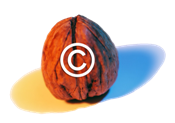The Film & Video Collection is not able to grant permissions to digitize, stream, cablecast or give public performances of moving image materials that have been purchased by the University of Delaware Library. All such rights are the property of the copyright owner(s). The Library is granted public performance rights at the time of purchase for some materials; this information is included in the item’s DELCAT record notes field as “Includes public performance rights”. These materials may be shown to a non-classroom audience without additional permissions provided attendees are not required to pay admission.
For information on copyright issues and other resources concerning current copyright law, go to the Copyright Research Guide and the University of Delaware Copyright Guidelines. For information on copyright issues as they pertain to media resources, please visit the links below.
The Film & Video Collection is not able to conduct copyright searches or obtain permissions from copyright owners to use copyrighted works, but may provide basic distributor information for films and videos.
Laws and regulations concerning copyright are complicated, but it is important for instructors to understand their implication so that they can make informed decisions about the resources they incorporate into their teaching. There are a range of exceptions that allow instructors to use copyrighted materials in a classroom setting.
A few important concepts and to keep in mind when considering Title 17 of the U.S. Code (Copyright) and the inclusion of media in a class setting:
Fair Use | Face-to-Face | TEACH Act | DMCA | Copyprotection | Other Resources
Fair Use (further information)
From Section 107:
Notwithstanding the provisions of sections 106 and 106A, the fair use of a copyrighted work, including such use by reproduction in copies or phonorecords or by any other means specified in that section, for purposes such as criticism, comment, news reporting, teaching (including multiple copies for classroom use), scholarship, or research, is not an infringement of copyright. In determining whether the use made of a work in any particular case is a fair use the factors to be considered shall include—
- The purpose and character of the use, including whether such use is of a commercial nature or is for nonprofit educational purposes;
- The nature of the copyrighted work;
- The amount and substantiality of the portion used in relation to the copyrighted work as a whole; and
- The effect of the use upon the potential market for or value of the copyrighted work.
The fact that a work is unpublished shall not itself bar a finding of fair use if such finding is made upon consideration of all the above factors.
Face-to-Face Teaching Exemption
From Section 110(1):
Notwithstanding the provisions of section 106, the following are not infringements of copyright:
(1) performance or display of a work by instructors or pupils in the course of face-to-face teaching activities of a nonprofit educational institution, in a classroom or similar place devoted to instruction, unless, in the case of a motion picture or other audiovisual work, the performance, or the display of individual images, is given by means of a copy that was not lawfully made under this title, and that the person responsible for the performance knew or had reason to believe was not lawfully made…
TEACH Act (further information)
From Section 110(2):
Notwithstanding the provisions of section 106, the following are not infringements of copyright: …
(2) except with respect to a work produced or marketed primarily for performance or display as part of mediated instructional activities transmitted via digital networks, or a performance or display that is given by means of a copy or phonorecord that is not lawfully made and acquired under this title, and the transmitting government body or accredited nonprofit educational institution knew or had reason to believe was not lawfully made and acquired, the performance of a nondramatic literary or musical work or reasonable and limited portions of any other work, or display of a work in an amount comparable to that which is typically displayed in the course of a live classroom session, by or in the course of a transmission, if —
(A) the performance or display is made by, at the direction of, or under the actual supervision of an instructor as an integral part of a class session offered as a regular part of the systematic mediated instructional activities of a governmental body or an accredited nonprofit educational institution;
(B) the performance or display is directly related and of material assistance to the teaching content of the transmission;
(C) the transmission is made solely for, and, to the extent technologically feasible, the reception of such transmission is limited to —
(i) students officially enrolled in the course for which the transmission is made; or
(ii) officers or employees of governmental bodies as a part of their official duties or employment; and
(D) the transmitting body or institution —
(i) institutes policies regarding copyright, provides informational materials to faculty, students, and relevant staff members that accurately describe, and promote compliance with, the laws of the United States relating to copyright, and provides notice to students that materials used in connection with the course may be subject to copyright protection; and
(ii) in the case of digital transmissions —
(I) applies technological measures that reasonably prevent —
(aa) retention of the work in accessible form by recipients of the transmission from the transmitting body or institution for longer than the class session; and
(bb) unauthorized further dissemination of the work in accessible form by such recipients to others; and
(II) does not engage in conduct that could reasonably be expected to interfere with technological measures used by copyright owners to prevent such retention or unauthorized further dissemination…
Digital Millenium Copyright Act (DMCA) (further information)
The DMCA was enacted in October 1998 primarily to bring U.S. copyright law into conformity with provisions of two World Intellectual Property Organization treaties to which the U. S. is a signatory. This Act facilitates the creation of a secure digital environment for use of copyrighted materials by encouraging the deployment of, and respect for, encryption and other technological protection systems. Accordingly, the DMCA prohibits (with certain limited exceptions): (1) manufacturing, importing, distributing, and providing products or services whose main purpose is to circumvent these systems; (2) taking action to engage in circumvention so as to gain unauthorized access to copyrighted works; and (3) removing, falsifying, or tampering with “copyright management information” (that is conveyed electronically with copyrighted works to identify them and their owners and provide other pertinent data about them). Beyond satisfying treaty obligations, the Act also seeks to clarify the rules for operating digital networks by (1) defining the circumstances that limit the liability of those entities that provide network services and (2) establishing procedures to facilitate the identification and correction of infringing activities engaged in by users through such networks.**
However…
Recent developments allow for certain exemptions:
Rulemaking on Exemptions from Prohibition on Circumvention of Technological Measures that Control Access to Copyrighted Works
The Librarian of Congress has announced the classes of works subject to the exemption from the prohibition against circumvention of technological measures that control access to copyrighted works. Persons making noninfringing uses of the following six classes of works will not be subject to the prohibition against circumventing access controls (17 U.S.C. § 1201(a)(1)) until the conclusion of the next rulemaking.
(1) Motion pictures on DVDs that are lawfully made and acquired and that are protected by the Content Scrambling System when circumvention is accomplished solely in order to accomplish the incorporation of short portions of motion pictures into new works for the purpose of criticism or comment, and where the person engaging in circumvention believes and has reasonable grounds for believing that circumvention is necessary to fulfill the purpose of the use in the following instances: (i) Educational uses by college and university professors and by college and university film and media studies students; (ii) Documentary filmmaking; (iii) Noncommercial videos…
Other Resources
- Copyright Advisory Network
- Copyright Crash Course (U of Texas – Austin)
- Copyright Advisory Office (Columbia University)
- Center for Media & Social Impact (American University)
- Copyright & Fair Use (Stanford University)

